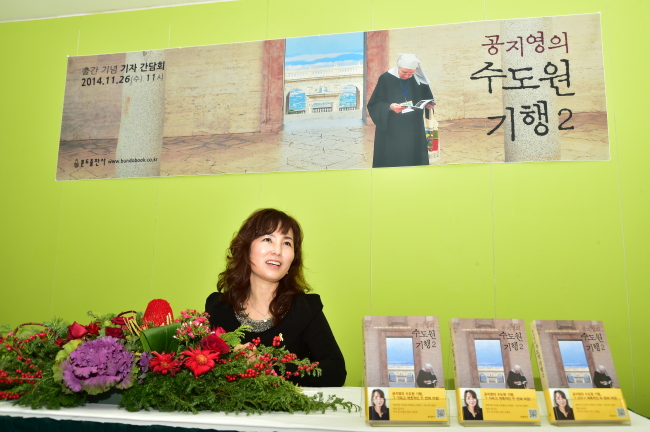Gong shares journey of faith
Author discusses her new book on her Catholic belief, ‘More of the Monastery Travelogue 2’
By Korea HeraldPublished : Nov. 27, 2014 - 21:09
Best-selling novelist Gong Ji-young, who has openly discussed themes including dictatorship, feminism and the labor movement in her works, recently published a new book on faith and her own spiritual journey, which also includes a section on her encounter with the Holy Spirit.
“More of the Monastery Travelogue 2” chronicles her visits to 11 monasteries here and abroad, including Waegwan Abbey in North Gyeongsang Province and Monte Cassino Abbey in Italy, over a three-year period. It has been 13 years since her book “Monastery Travelogue” came out in 2001.
“There are so many people living in pain, including Sewol ferry victims,” Gong said at a press conference in Jeong-dong, Seoul, on Wednesday. She wore a yellow ribbon on her outfit for the victims.
“Through this book, I wanted to offer solace to those who are suffering.”
Gong has realized that religious belief can have a huge effect on one’s life. “My life has become more comfortable, laid-back and less selfish after accepting that there is life after death,” she said.
“More of the Monastery Travelogue 2” chronicles her visits to 11 monasteries here and abroad, including Waegwan Abbey in North Gyeongsang Province and Monte Cassino Abbey in Italy, over a three-year period. It has been 13 years since her book “Monastery Travelogue” came out in 2001.
“There are so many people living in pain, including Sewol ferry victims,” Gong said at a press conference in Jeong-dong, Seoul, on Wednesday. She wore a yellow ribbon on her outfit for the victims.
“Through this book, I wanted to offer solace to those who are suffering.”
Gong has realized that religious belief can have a huge effect on one’s life. “My life has become more comfortable, laid-back and less selfish after accepting that there is life after death,” she said.

She is aware that she might be labeled as a “hallelujah ajumma” (a middle-aged female Christian) for writing about such spiritual experiences and stories that cannot be explained through logic or the laws of science.
“There have been many people who have asked for consultation on faith issues and their burdens through SNS,” said Gong, an active social networker in Korea. “I did not have enough time to reply to each and every one, so I thought this book can serve as an answer and give comfort.”
Gong, a Catholic baptized as Maria, wakes up at 5 a.m. every day and attends the morning service at a church close to her home. She prays for her kids and the more than 10 people who have asked her to pray for them.
“When I receive letters from many people, including people on the verge of suicide, I tell them one thing: ‘I cannot write you back all the time, but I can include your name when I light a candle and pray to God,’” she explained.
Gong realized that many people are healed merely by telling them she will pray for them. After a month or two, she received letters saying they had gotten better. “I ask them to let me know when they get better, because I already have many names to pray for,” she said.
At first, she had no intention to write the book: “When I was writing my 2013 novel ‘Blue, High, Ladder,’ I had an opportunity to visit Korean monasteries, including Waegwan Abbey.”
While visiting a number of monasteries, she had the desire to write about the monasteries and her in-depth spiritual journey at a deeper level than in the first book.
She included her vision-like encounter with the Holy Spirit at a monastery in Cologne, Germany, in 2002.
“Even before finishing the prayer, I felt a strong wind piercing through the crown of my head, passing my backbone and leaving my body through my collarbone, all in less than a second,” Gong writes in the book. She said she also found out last year that she fell down during this process.
She depicts monasteries as “heaven” and “good examples of communism.”
“When I went to the monasteries, it seemed like everyone was eating and living very well,” she said. “Maybe if one person doesn’t take everything (from society), this kind of ideal world can exist.”
She believes that old monasteries serve as models of the ideal community.
Gong also realized the importance of human labor while visiting the Benedictine monasteries: “It was beautiful to see monks and fathers work hard from morning to night each day to make a living.”
The 51-year-old, who has been a professional writer for more than 25 years, says that she used to think Marxism was what inspired her the most. But now, she has realized that her weekly voluntary service at orphanages, shelters and churches during her high school days under the Focolare Movement had the most influence on her life and helped shape her works.
By Ahn Sung-mi (sahn@heraldcorp.com)
-
Articles by Korea Herald











![[Today’s K-pop] BTS pop-up event to come to Seoul](http://res.heraldm.com/phpwas/restmb_idxmake.php?idx=644&simg=/content/image/2024/04/17/20240417050734_0.jpg&u=)
![[Graphic News] More Koreans say they plan long-distance trips this year](http://res.heraldm.com/phpwas/restmb_idxmake.php?idx=644&simg=/content/image/2024/04/17/20240417050828_0.gif&u=)





![[KH Explains] Hyundai's full hybrid edge to pay off amid slow transition to pure EVs](http://res.heraldm.com/phpwas/restmb_idxmake.php?idx=652&simg=/content/image/2024/04/18/20240418050645_0.jpg&u=20240419100350)

